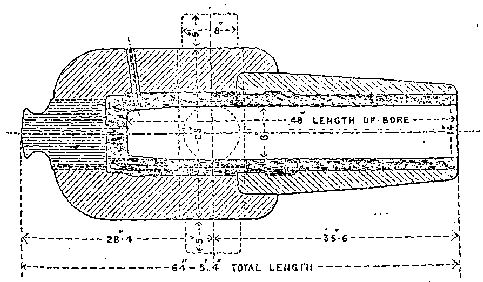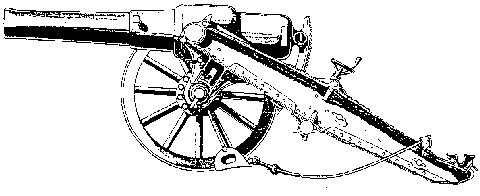The Gun - Rifled Ordnance: HowitzersOrdnanceIn smooth-bore days, howitzers were employed on what was called 'curved' or 'indirect' fire, eg firing at a target that was obscured by some intervening obstacle. On rare occasions they fired over the heads of troops they were supporting. During the Armstrong RBL era SBML howitzers continued to be used; no RBL howitzers were introduced. Field howitzers were normally found either singly or in pairs in each fire unit, eg a battery might have four guns and two howitzers, or five and one respectively. Being mounted on the same carriages as the guns, the pole-type trails of which restricted elevation to about 16°, their capabilities in the howitzer role were rather limited.Then in 1864 Field Marshal Sir J. Burgoyne drew attention to the necessity of improving the capabilities of existing howitzers, resulting in the Ordnance Select Committee of the day proposing a heavy rifled howitzer to fire up to elevations of 30°. Three 68-pr (8.05-in) carronades (short guns used mainly by Navy) were rifled, and the success of the experiments carried out with them led to a 32-pr bronze block being bored up to a calibre of 6.3 inches and rifled to take a 64-pr shell. The excellent results obtained with this piece prompted the Committee to propose a RML 6.3-inch howitzer. However, no further action took place at this stage. The power and advantages of high-angle fire from rifled artillery observed during foreign wars led in 1867 to a recommendation that an 8-inch rifled howitzer be produced. Designs from the Royal Gun Factory (RGF) for 8-, 9-, and 10-inch were considered, and in 1872 adoption of the 8-inch was confirmed. A number were made in 1873-74, constructed of steel and wrought iron and rifled on the Woolwich system with four grooves with a uniform twist of one turn in 16 calibres. The extreme shortness of the piece made this degree of twist necessary. |
 RML 8-inch 46-cwt Howitzer Mark 1 Except for the size, the 8-in howitzer closely resembled the 6.3-inch howitzer described below. The 8-inch had three clinometer planes (not shown on drawing), two on the jacket, one on the cascable. |
|
In 1874 the same committee, no doubt recalling the experiments of the 1860s, decided that a howitzer lighter than the 8-inch would also be desirable, and again proposed that on of 6.3-inch calibre be produced to fire the same projectile as the 64-pr gun. After length trials a 6.3-inch 18-cwt howitzer was adopted in 1878. The rifling was changed to the polygroove system, consisting of 20 grooves 0.1-inch deep and 0.5-inch broad. Twist increased from one turn in 100 calibres to one in 35 at the muzzle. With a full charge of 4 lbs RLG powder and a common shell of 69 lbs, MV was 751 fs. The 6.3-inch 18-cwt howitzer was the first piece in which projectiles without studs were fired, gas checks being attached to their bases. (See notes on RML ammunition to follow.)
These early howitzers were exceedingly short, especially the 8-inch. In 1876, realising that length was essential to power, new designs were submitted. However, owing to the time it took the authorities to decide what form the rifling was to take, manufacture of the longer designs was not completed until 1880. |
 8-inch 70-cwt howitzer |
|
The 8-inch 70-cwt howitzer superceded the 8-inch 46-cwt. Rifling in the heavier piece consisted of 24 grooves 0.05-inch deep and 0.7-inch wide. Twist increased from one turn in 90 calibres at the breech to one in 35 at the muzzle. With a full charge of 11¼ lbs RLG (rifle large grain) powder and a common shell of 180 lbs an MV of 956 fs was achieved. Note that howitzers fired shells only.
Instead of producing a heavier (and longer) 6.3-inch howitzer to match the 8-inch 70-cwt piece, a 6.6-inch howitzer was adopted in conjunction with the 6.6-inch gun. It closely resembled the 8-inch 70-cwt in form. Rifling of the 6.6-inch was PPS of 20 grooves 0.05-in deep, 0.7-in wide, with a twist increasing from one turn in 94 calibres to one in 35 at the muzzle. With a 100-lb shell and 5 lbs RLG powder MV was 839 fs. Although manufactured in 1877 the 6.6-inch howitzers were not rifled until 1880. The last RML howitzer to be made was the 4-inch 600 lb jointed piece of all steel construction. The piece consisted of the breech, trunnion, and muzzle portions, weighing 209, 192, and 199 lbs respectively. Each end of the trunnion ring was threaded internally to take the inner ends of the breech and muzzle portions. A quarter turn of the trunnion ring effected the union. Suitable rings at the junction prevented escape of the propellant gas. Presumably the howitzer was intended to be packed on mules but no record of its being so employed is known; perhaps it was found to be too heavy. |
 RML 4-inch 600-lb howitzer Rifling PPS Grooves 13 Depth 0.05-in Width 0.5-in Twist of rifling increasing to one turn in 25 calibres 38.7 inches from breech thereafter uniform at one turn in 25 calibres. Note drawing is not to same scale as for other howitzers. Length 57.45 inches. |
CarriagesIn construction RML howitzer carriages resembled RML gun carriages, and notes on the latter equally apply. The principal difference lay in the amount of elevation possible; RML howitzers were designed to permit 30°. Also, the heaviest types were designed to fire with the wheels removed, eg in prolonged siege operations, with the carriage and piece sitting on a prepared platform.The figure shows a typical example; the modifications to accommodate the different pieces of ordnance consisted mainly in adjusting the spacing and diameters of the trunnion beaarings. No drawings of the RML 8-in howitzer are available. |
 RML 4-inch jointed howitzer on carriage |
|
WL Ruffell previous | index | next | History index | Home |